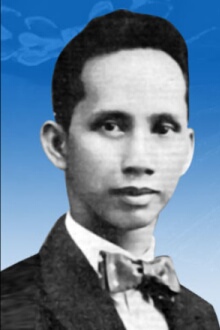This biographical article needs additional citations for verification. (October 2015) |
Antonio Jesús Naguiat Molina (December 26, 1894 – January 29, 1980) was a Filipino composer, conductor and music administrator. He was named a National Artist of the Philippines for his services to music. He was also known as the "Claude Debussy" of the Philippines due to his use of impressionist themes in music.[3]
Antonio Molina | |
|---|---|
 Antonio Molina from the Order of National Artists (NCCA) | |
| Born | Antonio Jesús Naguiat Molina December 26, 1894[1]: 147 [2] |
| Died | January 29, 1980 (aged 85)[2] |
| Nationality | Filipino |
| Occupation(s) | Composer, conductor and music administrator |
| Known for | Ana Maria, Hatinggabi |
| Awards | |
As a pioneer of the Philippine classical music scene, he led the first nationalistic movement in Philippine music.[4]
Early life
editMolina was born on December 26, 1894, in Quiapo, Manila, the son of Juan Molina, a government official, who founded the Molina Orchestra.[1]: 147 In 1902, he attended the Escuela Catolica de Nuestro Padre Jesus Nazareno in Quiapo, Manila,[3] and college at San Juan De Letran where he was awarded a Bachelor of Arts degree in 1909.
Molina's exposure to music at a young age laid him the foundation to become a composer and musician.[4] At an early age, he mastered playing the violoncello which led to his performance as an orchestra soloist at the Manila Grand Opera House.[5] Besides mastering the violoncello, he also explored other Western and indigenous instruments.[4]
Musical career
editMolina made his first composition in 1912 titled Matinal, which is preserved in an unpublished volume called Miniaturas, Vol. 1.[1]: 147 He was appointed to teach harmony, composition, music history, and violoncello at the University of the Philippines Conservatory of Music, pursuing a career in music education until being appointed dean of the Centro Escolar Conservatory of Music. He founded the Centro Escolar University String Quartet, which was professionally organized and financed by its music school.
As a composer, Molina is credited with over 500 compositions. Not only that, he also taught musical composers such as Felipe Padilla de Leon and Lucresia Kasilag, who would later become Philippine National Artists themselves.[2]
He also formed a number of rondalla groups in Manila.[6] One of these were the Rondalla Ideal which was founded and directed from 1909 to 1912 and the Rondalla Filharmonica Juvenal which was organized in 1913.[7][8] According to Molina, Filipino folk music and classical music at the time was in demand specially among the crew of American shipping companies.[7][8]
Molina was the first Filipino composer whose choral concert was televised in 1953.[9]
Musical style
editMolina was known to experiment with new ideas and innovate his own unique style of music. He infused Eastern modality with Western harmony and combined ethnic and native instruments with Western instruments.[4]
Influences
editMolina stated in his interview conducted by Helen F. Samson that his music was usually inspired by literature, with his favorite being La Novia Muerta by Ruben Daria.[1]: 146 His compositions such as his piano pieces like "Camia" (1942), "Malikmata" (1939), and "Mamer (Cradle Song)" (1960) were regarded as "literary interpretations".[10]
Death and legacy
editMolina died, aged 85, on January 29, 1980; a result of heart failure.[2]
According to the Philippine National Commission for Culture and the Arts, Molina is credited for introducing the whole tone scale, linear counterpoint, pentatonic scale, dominant ninths. and eleventh chords, especially in local Filipino music.[11]
References
edit- ^ a b c d Samson, Helen (1976). Contemporary Filipino Composers. Olongapo City: Manlapaz Publishing Company.
- ^ a b c d "Antonio J. Molina: 'Dean of Filipino Composers'". Inquirer News. INQUIRER.net.
- ^ a b Philippines, Cultural Center of the (1998). The National Artists of the Philippines. Cultural Center of the Philippines. ISBN 978-971-27-0782-7.
- ^ a b c d Molina, Katherine Frances Valdellon (2014). "Antonio J. Molina Beyond Affinity | Musika Jornal". Musika Jornal. 10: 17 – via UPD Journals.
- ^ "Antonio Molina". topicalphilippines.com. Retrieved 2024-07-17.
- ^ Getting the Meaning 6' 2000 Ed. Rex Bookstore, Inc. p. 124. ISBN 978-971-23-3062-9.
- ^ a b Filipino Heritage: The American Colonial period (1900-1941): Under the school bell. Lahing Pilipino Publishing. 1978.
- ^ a b The Dynamic Teeners of the 21st Century Ii ' 2005 Ed. Rex Bookstore, Inc. p. 16. ISBN 978-971-23-4046-8.
- ^ "Art 2 Art pays tribute to Antonio Molina". qa.philstar.com. 2010-11-28. Retrieved 2024-07-17.
- ^ Gil, Baby A. "To a Camia & other Phl melodies by Sally Pinkas". Philstar.com. Retrieved 2024-07-17.
- ^ "Order of National Artists: Antonio J. Molina". National Commission for Culture and the Arts. Retrieved 19 December 2023.
External links
edit- Works of Antonio J. Molina available at Tuklas from the University of the Philippines